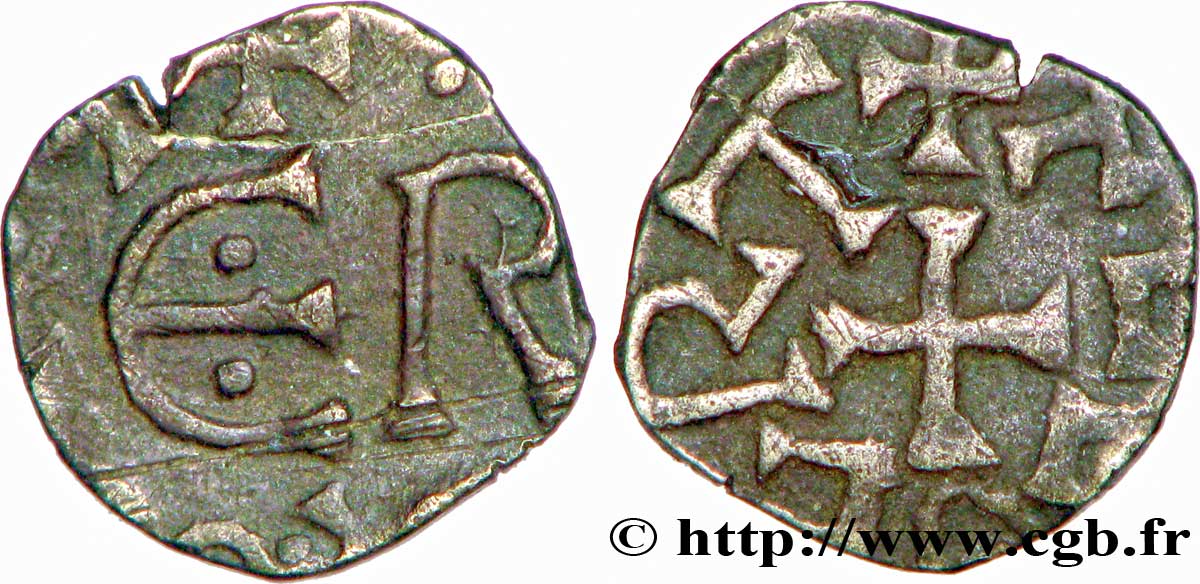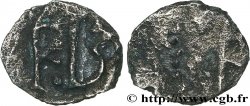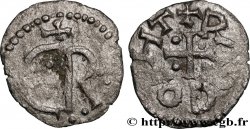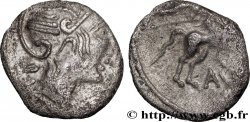v55_0612 - LIMOGES (LEMOVECAS) Denier ER
MONNAIES 55 (2012)
Начальная цена : 580.00 €
Назначить цену : 900.00 €
Цена реализации : 635.00 €
Количество ставок : 2
Максимальная предлагаемая цена : 678.00 €
Начальная цена : 580.00 €
Назначить цену : 900.00 €
Цена реализации : 635.00 €
Количество ставок : 2
Максимальная предлагаемая цена : 678.00 €
Тип Denier ER
Дата: (VIIe siècle)
Монетный двор / Город: Limoges (87)
Металл: silver
Диаметр: 12 mm
Ориентация осей монеты: 12 h.
Вес: 0,83 g.
Редкость: R3
Комментарии о состоянии
Petite monnaie très agréable, sur un flan un peu court avec une encoche sur la tranche, avec une cassure ancienne ayant été recollée, à peine perceptible au-dessus des lettres ER. Frappe vigoureuse avec de beaux reliefs et une patine grise de collection ancienne
Ссылки в каталоге: :
Лицевая сторона
Аверс: легенда: + LÉGENDE INDÉTERMINÉE.
Аверс: описание: ER en plein champ avec deux globules dans le E.
Обратная сторона
Реверс: легенда: + T (...) ERT.
Реверс: Описание: Petite croix ; légende autour.
Комментарий
Les lettres ER signifieraient Ecclesiae Racio. Ces deniers étaient classés de façon douteuse à Paris. D’Amécourt signale que ces monnaies ont été trouvées dans les dragages de la Loire. Aucune des monnaies publiées dans les divers ouvrages ne présente cette légende au revers ; son interprétation reste incertaine avec une partie de la légende en bord de flan.
Cette série est désormais attribué à l’église de Limoges et à Neuvic-d’Ussel (B. 6340). Ces monnaies sont rares et leur classement reste limité (cf. Moneta p. 134).
The letters ER would mean Ecclesiae Racio. These coins were classified in a dubious manner in Paris. D'Amécourt reports that these coins were found in the dredging of the Loire. None of the coins published in the various works have this legend on the reverse; its interpretation remains uncertain with part of the legend on the edge of the flan. This series is now attributed to the church of Limoges and to Neuvic-d'Ussel (B. 6340). These coins are rare and their classification remains limited (cf. Moneta p. 134)
Cette série est désormais attribué à l’église de Limoges et à Neuvic-d’Ussel (B. 6340). Ces monnaies sont rares et leur classement reste limité (cf. Moneta p. 134).
The letters ER would mean Ecclesiae Racio. These coins were classified in a dubious manner in Paris. D'Amécourt reports that these coins were found in the dredging of the Loire. None of the coins published in the various works have this legend on the reverse; its interpretation remains uncertain with part of the legend on the edge of the flan. This series is now attributed to the church of Limoges and to Neuvic-d'Ussel (B. 6340). These coins are rare and their classification remains limited (cf. Moneta p. 134)








 Cообщить об ошибке
Cообщить об ошибке Распечатать страницу
Распечатать страницу Отправить мой выбор
Отправить мой выбор Задать вопрос
Задать вопрос Consign / sell
Consign / sell
 Информация
Информация











